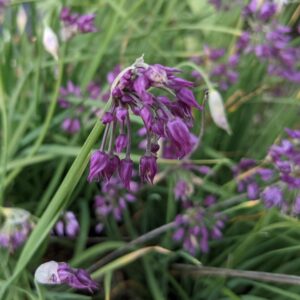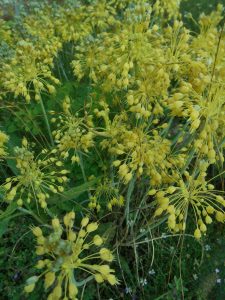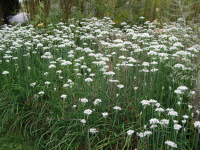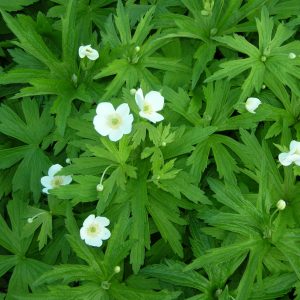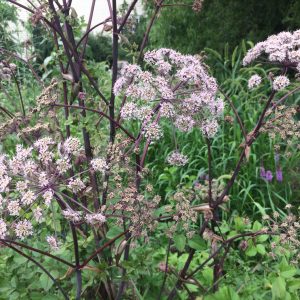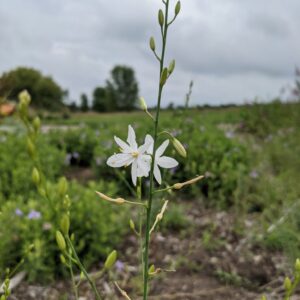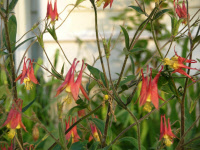Plants for Butterflies and Other Pollinators
Showing 9–16 of 211 results
-
Allium cyathophorum var. farreri Z 5-8
Clusters of nodding deep purple tubes flowering atop scapes in late spring to early summer above shorter grassy leaves.
Clusters of nodding deep purple tubes flowering atop scapes in late spring to early summer above shorter grassy leaves.
We are very sorry, but due to state agricultural restrictions, we are not permitted to ship Allium bulbs to Idaho, or to the following five counties in the State of Washington: Adams, Benton, Franklin, Grant and Klickitat.
Size: 6-12” x 9-12"
Care: sun to part shade in moist to moist well-drained soil
Native: mountains of northwestern China.
Wildlife Value: Alliums resist critters including deer, rabbits, squirrels, mice, and moles and voles. They cannot stand the onion-like smell of Alliums protecting near-by plants too.1st described in 1930. This variety named to honor intrepid plant explorer, writer and artist Reginald Farrer (1880-1920).
-
Allium flavum var. minus Yellow flowered garlic
Umbels of shatter-shot yellow florets, like fireworks, bloom atop blue-green stems in July.
Umbels of shatter-shot yellow florets, like fireworks, bloom atop blue-green stems in July.
We are very sorry, but due to state agricultural restrictions, we are not permitted to ship Allium bulbs to Idaho, or to the following five counties in the State of Washington: Adams, Benton, Franklin, Grant and Klickitat.
Size: 10” x 3”
Care: sun in moist well-drained soil
Native: Northern Turkey
Wildlife Value: Resists critters including deer, rabbits, squirrels, mice, and moles and voles. They cannot stand the onion-like smell of Alliums protecting near-by plants too. Attracts bees & butterflies
Awards: species received Royal Horticultural Society Award of Garden MeritDescribed by Swiss botanist Pierre Edmond Boissier before 1885
-
Allium senescens Corkscrew allium, German garlic, Greater mountain garlic Z 4-9
Lavender balls, up to 30 of them, atop thin, bluish, strap-like, twisting foliage – mid-summer day’s dream.
Lavender balls, up to 30 of them, atop thin, bluish, strap-like, twisting foliage – mid-summer day’s dream.
We are very sorry, but due to state agricultural restrictions, we are not permitted to ship Allium bulbs to Idaho, or to the following five counties in the State of Washington: Adams, Benton, Franklin, Grant and Klickitat.
Size: 6-12” x 6-12”
Care: sun to part shade in well-drained to moist well-drained soil
Native: Siberia
Wildlife Value: Attracts butterflies & bees. Resists critters including deer, rabbits, squirrels, mice, and moles and voles. They cannot stand the onion-like smell of Alliums protecting near-by plants too.Cultivated before 1753. According to Philip Miller’s 1768 Dictionary, “planted in gardens for the variety of their flowers.” Grown at America’s 1st botanic garden, Elgin Botanic Garden 1811.
-
Allium tuberosum Garlic chives Z 4-8
August & September bright white balls the size of golf balls on erect stems. Ornamental in gardens and in arrangements, both fresh and dried, delicious edible.
August & September bright white balls the size of golf balls on erect stems. . Ornamental in gardens and in arrangements, both fresh and dried, delicious edible.
We are very sorry, but due to state agricultural restrictions, we are not permitted to ship Allium bulbs to Idaho, or to the following five counties in the State of Washington: Adams, Benton, Franklin, Grant and Klickitat.
Size: 12-18” x 8”
Care: Full sun or shade in any soil
Native: Southeast Asia
Wildlife Value: nectar source for many butterlies including the Tiger Swallowtail. Resists critters including deer, rabbits, squirrels, mice, and moles. They cannot stand the onion-like smell of Alliums protecting near-by plants too.Used medicinally in Asia as a remedy for incontinence, bladder weakness, kidney trouble and knee injuries. Traditional Chinese medicine practitioners made a powder from the seeds called Jiu Cai Zi used for numerous ailments.
-
Anemone canadensis Meadow anemone Z 3-8
Pristine pure white petal-like sepals frame many golden anthers in early summer
Pristine pure white petal-like sepals frame many golden anthers in early summer
Size: 12-24" x 12” spreading
Care: full sun to part shade in moist soil or moist well-drained soil
Native: North America as far south as Missouri, Wisconsin native
Wildlife Value: pollen for small bees
Size: Good groundcover under trees where soil is moist, naturalized garden.Collected by Meriwether Lewis August 17, 1804 on the 1st leg of the Expedition. Used medicinally by many Indian groups. The roots cleared up sores and leaves stopped nose bleeds for the Chippewa. It relieved the Iroquois of worms and counteracted witch medicine. For the Meskwaki this plant uncrossed crossed eyes. Ojibwa singers used it to clear their throats and remedy lower back pain. Sioux used the root to remedy several ailments – staunch bleeding, reduce lower back pain, sore eyes, crossed eyes and twitching of eyes. They also ate the root to clear the throat to boost good singing.
-
Angelica sylvestris ‘Purpurea’ Wild Angelica Self-seeding Biennial Z 4-9
Imposing, glossy, deep purple stems and buds with large umbels of mauve to dusky pink to purplish late summer-early fall.
Imposing, glossy, deep purple stems and buds with large umbels of mauve to dusky pink to purplish late summer-early fall.
Can not ship to : Maine
Size: 5-6' x 5'
Care: sun to part shade in moist to moist well-drained soil. Be sure to let the flowers drop its seeds and do not weed the seedlings out the following spring. It reseeds readily from fresh seed
Native: Europe in moist woodlands and bogs.
Wildlife Value: attracts bees and butterfliesFresh stems or boiled leaves eaten medicinally to cure scurvy. In Austria made into a tea to remedy infections, flu, stomach ailments and respiratory ailments. The species described in Species Plantarum 1: 251. 1753 (1 May 1753) by Linnaeus. William Jackson Hooker described the wild species growing in England as having “stem purplish, pubescent above, as well as the umbels.” The British Flora p. 180 (1860)
-
Anthericum ramosum Spider plant, Branched St Bernard’s-lily Z 5-8
White, branched flower clusters above grass-like leaves June-August
OUT OF STOCK – EMAIL FOR AVAILABILITY
White, branched flower clusters above grass-like leaves June-August
Size: 2-3’ x 12”
Care: full sun in well-drained soil
Native: Western, Central & Southern Europe
Wildlife Value: Attracts bees, butterflies and hummingbirdsPublished by Linneaus in Species Plantarum (1753)
-
Aquilegia canadensis Canada Columbine Z 3-9
In May and June yellow petticoats peek out from under eye-popping red skirts flaring at the ends as these flowers dangle from tall stems.
In May and June yellow petticoats peek out from under eye-popping red skirts flaring at the ends as these flowers dangle from tall stems.
Size: 24-36”x 12”
Care: part shade in moist well-drained soil - moist in spring & dry in summer
Native: Eastern Canada to Florida, west to New Mexico, Wisconsin native.
Wildlife Value: Provides rich, early spring nectar for bumblebees, bees, butterflies, and hummingbirds. Buntings and finches eat seeds. Sole food source for Columbine duskywing caterpillar.
Awards: England’s Royal Horticultural Society Award of Merit.Seeds are fragrant when crushed, used by Omaha, Ponca and Pawnee as perfume. Pawnee used the plant as a love charm by rubbing pulverized seeds in palm of hand and endeavoring to shake hand of desired person. Crushed seeds also used to cure fever and headaches. Cherokee made a tea for heart trouble. The Iroquois used the plant to cure poisoning and to detect people who were bewitched. Grown by Tradescant the Elder in England in 1632. He may have received it from France. Cultivated by Washington & Jefferson. Grown at America’s 1st botanic garden, Elgin Botanic Garden 1811.

